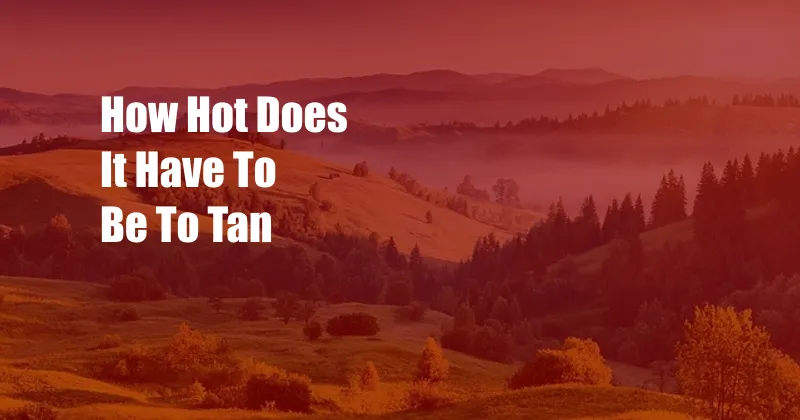
How Hot Does it Have to Be to Tan?
As I lay basking in the sun’s golden rays, I couldn’t help but wonder, “How hot does it have to be to tan?” I’ve always been fascinated by the science of tanning, and I was eager to delve deeper into the topic. My quest for knowledge led me to a world of fascinating discoveries that I am excited to share with you in this comprehensive guide.
Let’s begin our journey by understanding the basics of tanning. When our skin is exposed to ultraviolet (UV) radiation from the sun or tanning beds, our body produces melanin, a pigment that gives our skin its color. This natural defense mechanism helps protect our skin from the harmful effects of UV radiation, but it also gives us that coveted golden glow we associate with a tan.
The Science of Tanning
The sun emits three types of UV radiation: UVA, UVB, and UVC. UVC radiation is the most harmful, but it is mostly absorbed by the ozone layer, so it doesn’t reach our skin. UVA and UVB radiation, on the other hand, can penetrate our skin and cause damage, including sunburn and skin cancer. However, UVB radiation is primarily responsible for tanning, as it triggers the production of melanin.
The intensity of UV radiation varies depending on several factors, including the time of day, season, latitude, and weather conditions. The sun’s rays are strongest during the middle of the day, particularly during the summer months. Additionally, people living closer to the equator experience higher levels of UV radiation due to the shorter distance between the sun and the Earth’s surface. Finally, clear and sunny weather conditions allow for maximum UV exposure compared to cloudy or overcast days.
The Optimal Temperature for Tanning
Now, let’s address the question that brought us here: How hot does it have to be to tan? While temperature itself does not directly affect tanning, it does play an indirect role. Higher temperatures typically coincide with clearer skies and more intense sunlight, which means more UV radiation reaching our skin. Therefore, tanning is generally more effective on warm, sunny days when the UV index is high.
The optimal temperature for tanning varies depending on your individual skin type. Fair-skinned individuals with a tendency to burn easily should avoid tanning when the temperature exceeds 85°F (29°C). They should also limit their exposure to short intervals of 10-15 minutes to prevent sunburn. Those with darker skin tones can tolerate higher temperatures and may prefer to tan when the temperature is around 90°F (32°C) or higher.
Tips for Safe Tanning
While tanning can give you a beautiful glow, it’s essential to approach it safely to minimize the risks associated with UV exposure. Here are a few expert tips to help you tan responsibly:
- Choose the right time of day: Avoid tanning during peak hours (10 am to 4 pm) when the sun’s rays are strongest.
- Start gradually: Begin with short tanning sessions (10-15 minutes) and gradually increase the duration as your skin develops a base tan.
- Protect your skin: Use sunscreen with an SPF of 30 or higher, and reapply every two hours, even if you’re not actively tanning.
- Wear sunglasses and a hat: Protect your eyes and scalp, which are particularly sensitive to UV radiation.
- Stay hydrated: Drink plenty of water before, during, and after tanning to prevent dehydration.
By following these tips, you can minimize the risks associated with tanning and enjoy a sun-kissed glow without compromising your health.
FAQs about Tanning
- Q: Can I tan on a cloudy day?
A: Yes, you can still tan on a cloudy day, but the intensity of UV radiation is reduced, so it will take longer to achieve a tan. - Q: Is it safe to use tanning beds?
A: Tanning beds emit high levels of UV radiation, which can increase your risk of skin cancer and premature aging. It’s generally recommended to avoid using tanning beds. - Q: What are the signs of sunburn?
A: Sunburn can cause redness, pain, swelling, blisters, and peeling skin. If you experience any of these symptoms, it’s important to seek medical attention. - Q: How can I remove a tan?
A: A tan will naturally fade over time, but you can speed up the process by using exfoliating scrubs, skin lightening products, or consulting with a dermatologist.
Conclusion
Understanding how hot it has to be to tan is crucial for achieving a safe and healthy tan. By considering factors such as UV intensity, skin type, and safety precautions, you can enjoy the benefits of a sun-kissed glow without compromising your well-being.
If you have any further questions about tanning or would like to explore this topic further, I encourage you to leave a comment below or browse our other related articles. Thank you for reading, and happy tanning!